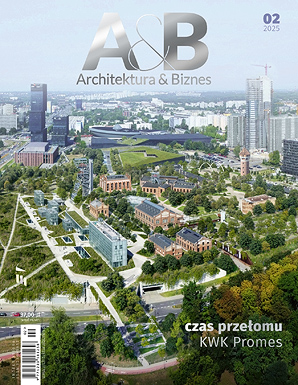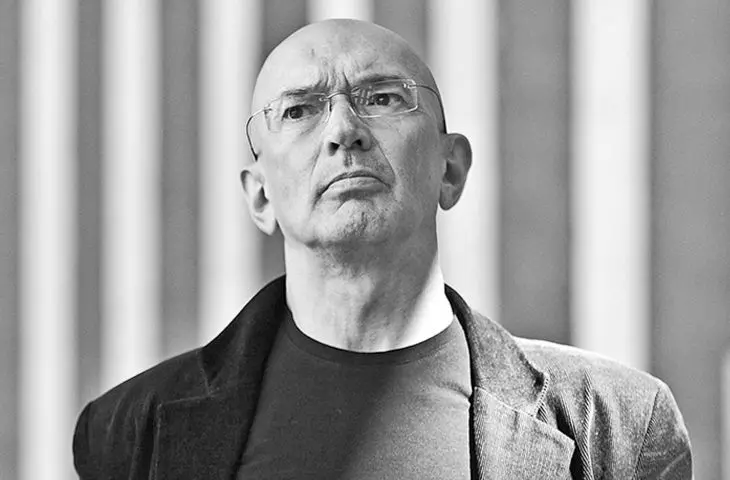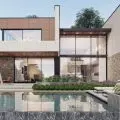The interview comes from A&B issue 6|24 issue
One of the greatest honors in Polish architecture is the Honorary Award of the Society of Architects (SARP), which has been awarded since 1966. In a new series in the pages of A&B about the professional path, the activities of SARP and current events from the world of architecture, Wojciech Fudala talks to the laureates of this award. This time his interlocutor is Professor Boleslaw Stelmach, winner of the 2010 SARP Honorary Award.
Boleslaw Stelmach — professor. He graduated from the Faculty of Architecture at the Cracow University of Technology in 1980, and in 1988 he completed postgraduate studies in urban planning at the Faculty of Architecture at the Warsaw University of Technology. He received his doctorate in architectural engineering in 2009, his postdoctoral degree from the Faculty of Architecture at the Warsaw University of Technology in 2016, and his professorship in engineering sciences in the discipline of architecture and urban planning in 2022. As of 2019, he is a professor at the Technical University of Lodz. General designer at Stelmach and Partners Architectural Office existing since 1992. The studio specializes in urban and architectural projects for cities, gardens and houses. The area of the office's activity covers the whole of Poland, and the main office is located in Lublin. In 2010, the Association of Polish Architects awarded it its highest honor — the SARP Honorary Award. In 2012, he was awarded the Bronze Medal Gloria Artis by the Minister of Culture of the Republic of Poland for his special contributions to Polish culture, and in 2015 he received the Officer's Cross of the Order of Rebirth of Poland for his outstanding contributions in the field of architecture. In 2017, he was awarded the Annual Prize of the Minister of Culture and National Heritage in the field of architecture. Since November 2017, he has served as Director of the National Institute of Architecture and Urbanism in Warsaw.
Wojciech Fudala: We have started all previous conversations with SARP Honorary Award winners by introducing the beginnings of their design office. What did that look like in the case of Stelmach and Partners?
Boleslaw Stelmach: Our studio is made up of five equal partners: Marek Zarzeczny, Rafał Szmigielski, Sławomir Kłos, Zbigniew Wypych and myself. We have been operating in this team of authors since 1992 until today.
The beginnings of our studio were at a time when Poland, as a capitalist country, entered the orbit of European business, and new needs emerged in architecture. We started by designing banks and gas stations for foreign corporations — that's how we earned our keep, at the same time we took part in competitions.
Expansion of the Sejm of the Republic of Poland, Warsaw, Al. Na Skarpie, design: 2006, implementation: 2008-2010
Photo: Marcin Czechowicz © Illustrations courtesy of Stelmach and Partners Architectural Office
At first we took third places or got honorable mentions, until finally in 1995 we managed to win a competition for an Accessible House in Warsaw. Later, God gave us several more victories in large competitions, such as the expansion of the Sejm, the Foksal quarter, the Chopin Center, the expansion of the Frederic Chopin Museum and the revalorization of the park in Żelazowa Wola. We are also very much involved in competitions today, as we are interested in creating architecture as an area of art. However, I would not describe our studio as an "architectural office", but more as a workshop.
Wojciech Fudala: How does such a "workshop" differ from an architectural "office"?
Boleslaw Stelmach: We have chosen the path of drawing with our own hands, like forging in a quarry. Each of us draws, leads the subject, supervises and builds. Of course, the composition of the team changes depending on the size of the subject and needs. Sometimes it's three people, and other times it's thirty people, usually excellent young architects, but who are less experienced and work under the supervision of my regular partners.
I recently spoke with a friend of mine, a well-known Warsaw architect. I say to him: "I was recently in Praga, where I saw an interesting house. Is this your project?". He says: "And how can I know? I have two hundred employees and I don't know all the projects that come out of our office". Well, we know what we design, and that is our philosophy in this very beautiful, though very difficult profession.
Wojciech Fudala: Today you can boast a huge body of work. However, I would describe most of your projects as background architecture. Is this a deliberate action?
Boleslaw Stelmach: We never fantasize about the space. We don't come with the idea that here there will be something spiral and somewhere else there will be a zigzag. Every time we look at a place and ask that place what kind of house should be in that place. We try to imagine what could grow in this place, like a tree growing from local materials and local premises.
The next stage, of course, is the endless internal research and discussions. Often, until the very last minute, there are ongoing deliberations in our studio. Should there be an opening or a closing at this location? A 6:10 ratio or some other? This rhythm or another?
Expansion of the Polish Parliament, Warsaw, Al. Na Skarpie, design: 2006, implementation: 2008-2010
Photo: Marcin Czechowicz © Illustrations courtesy of Stelmach and Partners Architectural Office
I think you have aptly defined that we are trying to do background architecture. However, I have to admit that this is perceived differently. For example, one of the most famous Polish architects said to me, "You make such aggressive houses that are oppressive". I was a bit surprised by this, but I understand that someone can have this point of view. We consciously try to avoid it. We have some idea of beauty, but not in a purely aesthetic dimension, but understood as beauty of structure, beauty of materials and beauty of proportion. We like it when one follows logically from the other and when the building seems to be an integral part of the place where it was built. We strive for a house to have only what it needs to have, and nothing more. But also no less. For us, a smart house is beautiful.
Wojciech Fudala: When we talked about competition successes, they all concerned those held in or around Warsaw. Why did the studio from Lublin focus its activities on the capital?
Boleslaw Stelmach: We don't focus exclusively on Warsaw, we have also won competitions for the Science and Technology Park or the Meeting of Cultures Center in Lublin or the National Museum in Krakow, for example. However, Warsaw has the largest number of these competitions, so proportionally it is there that we win more often. Of course, for every contest won, there are a couple of lost.
I must also admit that the Warsaw branch of SARP has always been extremely active in the area of competitions. It is not uncommon for these to be international competitions in which studios like David Chipperfield Architects or Zaha Hadid Architects compete. Much of the credit for this goes to young Polish architects, who, after graduation, find their way to large foreign offices, encouraging them to participate in competitions in our country. I know of such cases from Japan to Finland.
Wojciech Fudala: And what do such foreign architects think when the realization of objects from already decided competitions is stopped? I'm thinking of the reconstruction of the Cracovia Hotel to function as the Museum of Design and Architecture in Krakow (proj.: Biuro Projektów Lewicki Łatak), as well as your winning project for the Theatre of the Polish Royal Opera House in Warsaw.
Boleslaw Stelmach: These are, of course, political decisions. Politicians or ministers have the right to make decisions that are in line with their cultural policy. The elections have decided that this and not another cultural policy will be implemented, and I have nothing to comment on here.
Anyone who designs public buildings must reckon with this situation. Just as he has to reckon with the fact that from one day to the next the funds for the realization of a facility will run out. We are still a very unstable country from the point of view of public procurement and the budget allocated for it.
Chopin Center, Warsaw, Tamka Street, design: 2005, implementation: 2007-2010
Photo: Marcin Czechowicz © Illustrations courtesy of Stelmach and Partners Architectural Office
For the past thirty years, all those who executed public contracts were in a precarious position. The contracting authority, representing an institution that spends budgeted funds within the framework of so-called budgetary discipline, could let an architect or contractor off the hook at any time. The courts then admit that these very institutions are right. Unfortunately, the paths of jurisprudence in the field of public procurement are such that the most important thing is not to harm the institution, because in this way you will not harm yourself — lawyers, directors. And the fact that, as a consequence, some investment will not be realized, nobody cares at all, because he will not be responsible for it.
Wojciech Fudala: We often emphasize that a competition is a public pledge. In practice, however, when the authorities change, one decision can bury many years of work by predecessors. I myself competed in the competition for the redevelopment of the Cracovia Hotel, and my project won an honorable mention. I believe that this competition was a sensational initiative and a model example of giving new life to a monument of modernism. Shouldn't such things be above political divisions?
Boleslaw Stelmach: Yes, the Cracovia Hotel is a very good example. Its implementation is in the interest of Poland and in the interest of the position of Polish culture in Europe and the world. After the communist era, we are not even halfway there yet in terms of saturation with cultural facilities compared to Western countries. The realization of large buildings such as the National Forum of Music in Wroclaw [designed by Kurylowicz & Associates — editor's note] or the Museum of Modern Art in Warsaw [designed by Thomas Phifer and Partners — editor's note] is nothing more than filling this painful gap that exists in the socio-cultural structure of Poland.
However, there is still a monstrous backlog to catch up with. When someone who comes to power says that we can't afford it, I am reminded of the words attributed to Winston Churchill, who, on the proposal to seek savings in culture in the face of war, is supposed to have said, "If we cut for culture, what will we fight for?".
Wojciech Fudala: Let's jump for a moment to the Royal Polish Opera Theater. I remember when architect Friedrich Ludewig of the ACME studio came to Katowice in 2014 to give a lecture in SARP's Masters of Architecture series. At the time, he showed the design of the SAB bank headquarters in Leipzig, just after winning the competition. After the results were announced for the Royal Opera House Theater, there were claims in the community that your winning design was a copy of this building by ACME. Could you comment on this?
Boleslaw Stelmach: In designing the Theatre of the Polish Royal Opera House, we were inspired by the organic form of mushrooms and trees; in terms of architecture, we thought of the Johnson Wax building in Wisconsin, by Frank Lloyd Wright. Before making statements that our design is a copy of the one in Leipzig, one should ask oneself who actually came first and who used what inspiration? Unfortunately, most of the people commenting are simply not familiar with this defunct Wright building.
Park of the Fryderyk Chopin Museum in Żelazowa Wola, project: 2006-2007, implementation: 2008-2010
Photo: Marcin Czechowicz © Illustrations provided courtesy of Stelmach and Partners Architectural Office
Wojciech Fudala: There is one winner and dozens of losers in a competition, so this can cause frustration and various comments. Would you encourage young architects these days to participate in competitions?
Boleslaw Stelmach: First of all, I encourage them to become members of SARP and be active. I believe that this is the only way to turn this generational discontent into space value and social value.
As for competitions, this is, in my opinion, the best way to get a commission. We, as an architectural office, have been following this path from the very beginning. However, I know that younger colleagues think that it doesn't make sense, because older architects award each other prizes in competitions anyway. I disagree with this. In the last three decades, young people have won in many architectural competitions. Just recall HS99, WXCA, Mąka Sojka or Zbyszek Maćkow. They all started their careers as young teams by winning SARP competitions.
Wojciech Fudala: When and why did you join SARP?
Boleslaw Stelmach: I joined in 1980, so right after college. I was encouraged by my teachers, such as Przemysław Szafer, Witold Cęckiewicz, Witold Korski, Wojciech Kosiński, Jurek Gurawski and Grażyna Schneider-Skalska. All these architects, whom I admired and thanks to whom I am worth something in architecture at all, were members of SARP. I wanted to follow in their footsteps, so enrolling in the Association was a natural path for me.
Wojciech Fudala: Today the reality is a little different. Last year, representing SARP Katowice, I attended the SARP U40 meeting in Krakow. However, many SARP branches were not represented there by a single representative. Why are young architects today no longer so eager to be active in the Association?
Boleslaw Stelmach: First of all, because they are busy with other things. I often talk to young architects because, as a university teacher, I conduct master's degrees. During casual conversations they ask: "Why do we actually need this SARP?" For them, competitions are a waste of time and money. They have other priorities. Today we have many more opportunities than in the 1980s or 1990s.
Lublin Science Park, Lublin, Dobrzyńskiego Street, design and implementation: 2004-2013
Photo: Marcin Czechowicz © Illustrations courtesy of Stelmach and Partners Architectural Office
Wojciech Fudala: What is your answer to that? Why do we actually need this SARP?
Boleslaw Stelmach: If someone criticizes what we are doing in SARP, then they should join it precisely to change it from within. SARP needs young people, it needs their hearts, talents and energy. The Warsaw Branch is a positive example of this — for several terms it has been run by young architects with less than ten years of experience in the profession. Thanks to their commitment, in my opinion, it functions best in Poland, including in the area of competitions.
Wojciech Fudala: Now I would like to talk about the National Institute of Architecture and Urbanism, of which you are the director. How did it come into existence?
Boleslaw Stelmach: The Institute of Architecture already existed before World War II and immediately after the war. However, Wladyslaw Gomulka's coming to power meant that architects were no longer needed and in 1948 the Institute was closed. The Stalinist team regarded architecture as a means of influencing social thinking and the perception of power. When we read excerpts from the transcripts of the Politburo of the Central Committee of the Polish United Workers' Party, we see that Boleslaw Bierut had a vested interest in architecture and manually controlled it himself. He told, for example, what the sculpture on Constitution Square should look like or how many arms the lantern-candelabra located there should have. Such things were discussed not by architects, but by the Political Bureau of the Polish United Workers' Party, so urban planning and architecture were important.
But after 1956 came a time when the field of architecture was taken over by state construction organizations, the so-called Unifications. The Communists in power determined that low-cost housing had to be built, so typical (repetitive) designs and prefabrication emerged. Later, already under Gierek, thirty house factories were purchased from the Soviet Union. Architects were included in the technological sequence of housing production as one of the trades, on a par with construction or sanitary installations. At that time there was no question of practicing the free profession of architecture.
Meeting of Cultures Center - Theater under Construction, Lublin, Theater Square, design and construction: 2009-2016
Photo: Marcin Czechowicz © Illustrations courtesy of Stelmach and Partners Architectural Office
Architects fought for decades to change their status, and one of the demands was the establishment of the Institute. After the political transformation, the restoration of the National Institute of Architecture and Urban Planning was raised at successive SARP conventions. In 2013, as a delegate of the architectural community and Chairman of the Main Committee on Urbanism and Architecture, I went with this project to Deputy Prime Minister Elżbieta Bieńkowska. The Undersecretary of State in the Ministry of Infrastructure at the time was architect Janusz Żbik, who officially supported my proposal. However, the prime minister said that her government's philosophy was to reduce the state's participation in social and economic life, and it was not why she was abolishing a hundred institutes to create another one. Subsequent governments that followed responded in exactly the same way.
It wasn't until 2017, when I was once again with yet another prime minister, that a miracle happened. Minister Gliński said he agreed and that we could establish the Institute. We were given full-time positions, funding, and were able to rent an office, located at 4 Foksal Street in Warsaw.
Wojciech Fudala: How does the Institute currently function?
Boleslaw Stelmach: We have five departments and three-four full-time positions in each of them. One of them is the scientific department, which collects the legacy of outstanding architects, for example, Przemyslaw Szafer, Teresa Zarębska or the Bulanda Mucha studio. So it deals with things that build the identity of the history of Polish architecture.
We also have an exhibition department run by the young architect Kacper Kępiński. We recently had an exhibition by Maciej and Stanisława Nowicki at the United Nations headquarters in New York. Its opening was attended by crowds of people, including the President of the Assembly. This is the case at all of our exhibitions, well maybe the UN President doesn't always attend.
Atrium Hydrotherapy Center, Naleczow, Grabowa Street, design: 2003, implementation: 2003-2004
Photo: Marcin Czechowicz © Illustrations courtesy of Stelmach and Partners Architectural Office
It is also worth mentioning the publishing department, whose books can be purchased in art bookstores, such as Bęc Zmiana, or those located in Polish museums. We publish four-five books a year, striving to make them not only substantive, but also beautifully designed and published, for which they often receive awards and prizes, such as "CIAM Archipelago. Letters of Helena Syrkus". I recommend it to everyone who wants to learn about the fate of Polish modernists trying to help the communist authorities transform space and do socially acceptable things. There are other books in the pipeline, such as "The Complete Works of Jozef Rykwert" and the "Thinkers for Architects" series.
Another very important section is education. Each exhibition or publication is linked to workshops or seminars. They are attended by people of different ages: from pre-school children to universities of the third age. All of them are extremely popular. We already have a second year of postgraduates preparing tutors in the field of architecture and urban planning. I invite you to visit our website at www.niaiu.pl to learn more about the Institute's offerings.
Wojciech Fudala: What benefits do architects currently in the market derive from the existence of NIAiU?
Boleslaw Stelmach: If one wants to design consciously, one must be familiar with at least Rykwert or other publications issued by NIAiU. Later this year we are planning to publish Professor Ewa Kurylowicz's book "Theory for Practice". A whole lot of clever stuff will appear there. It is worth looking at the theoretical dimension, which was represented by Prof. Stefan Kurylowicz, and whose thought is continued today by Prof. Ewa Kurylowicz. Their office has been one of the most important in Poland for several decades.
Szucha Premium Offices, Warsaw, J. Ch. Szucha Avenue, design and construction: 2013-2017
Photo: Marcin Czechowicz © Illustrations provided courtesy of Stelmach and Partners Architectural Office
We will also work on monographs as much as possible. I promise myself that we will lean on monumental architects, such as Marek Budzynski, who influenced a whole generation of his own and younger colleagues. He is recognized in the world as the one who blazed the trail for pro-ecological architecture, and in our country he doesn't get the recognition he should. By force, these architects, who are a generation older, enter the shadows of oblivion. It often takes several more generations to rediscover these architects. And the Institute does not want to wait, but to discover these architects now.
NIAiU, at the request of the community, is also initiating legislative changes. It has succeeded in introducing in the Public Procurement Law an obligation to select by competition all concepts and resulting designs for buildings constructed with public funds. Together with the Chamber of Architects and the SARP, we have led to the recommendation of regulations for such competitions by the Public Procurement Office. We are currently negotiating with successive governments to minimize and simplify procedures and requirements for building permits.
Wojciech Fudala: Aren't you afraid that, for political reasons, the National Institute of Architecture and Urban Planning may be closed again?
Boleslaw Stelmach: I have no influence on this, so I don't think about it at all. The singer and excellent poet, Wojciech Mlynarski, used to say "Let's do our own thing!". That's what we're doing.
Wojciech Fudala: What do you think are the biggest challenges facing Polish and world architecture?
Boleslaw Stelmach: I like to go back to the series of essays and discussions in Architectural Review, which began with an article by Peter Buchanan. He talks about how old-architects are such a last glimmer of the setting modernist sun. Now, in order to gain public acceptance, architects will have to play a role for the community in which they have come to live.
Polish architecture has always followed the paths previously mapped out by Western elites. This is how it was and, in my opinion, will remain so. Today, the West is leading us to think pro-ecological, but also to think of man as an integral, authentic individual who contains a Divine particle within himself. Architects have the privilege of being able to build a room, an apartment, a house, an estate or a city for him. This is an absolutely unique role, but also a great responsibility.
Expansion of the Sejm of the Republic of Poland Building of the Sejm Commissions, Warsaw, Wiejska Street, design: 2013-2015, implementation: 2016-2018
Photo: Marcin Czechowicz © Illustrations provided courtesy of Stelmach and Partners Architectural Office
Wojciech Fudala: And when you look back at the past, what are you most proud of?
Boleslaw Stelmach: I don't look back, because I'm most proud of the fact that there is another project waiting for us in the studio. Every building we draw at the moment is the most important project for us, because it is the one that is yet to be built. All our dreams, our expectations, our knowledge and our talent are focused there. I don't look to the past, because the best is yet to come.
Wojciech Fudala: Thank you for the interview.











































